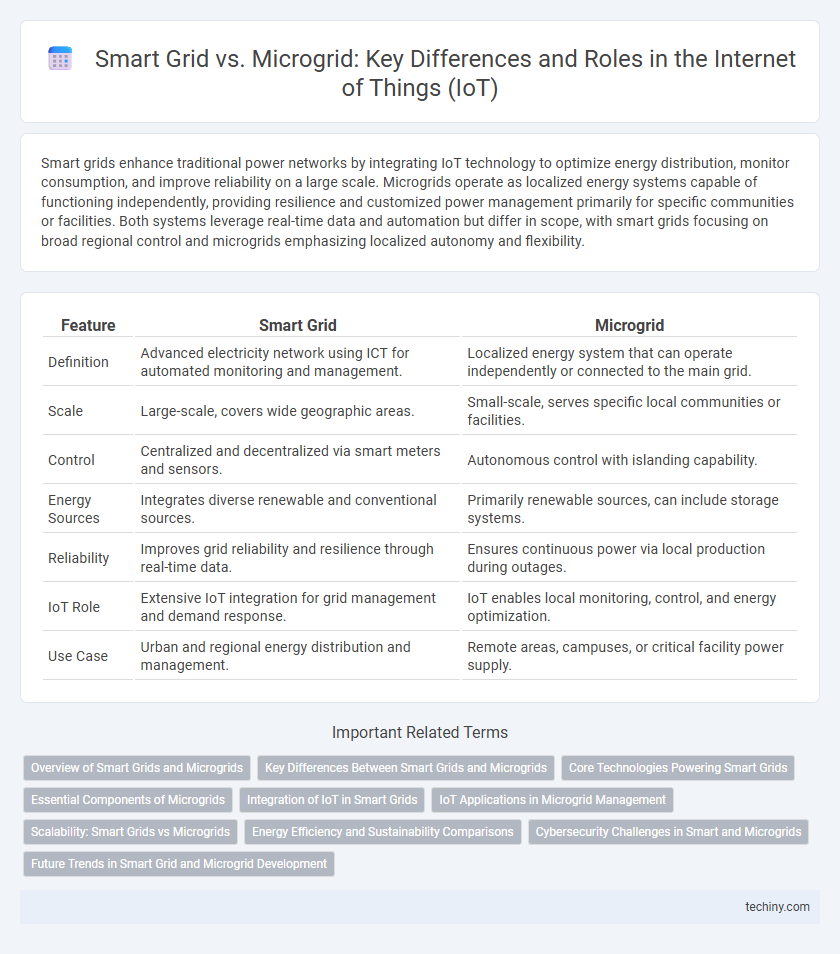Smart grids enhance traditional power networks by integrating IoT technology to optimize energy distribution, monitor consumption, and improve reliability on a large scale. Microgrids operate as localized energy systems capable of functioning independently, providing resilience and customized power management primarily for specific communities or facilities. Both systems leverage real-time data and automation but differ in scope, with smart grids focusing on broad regional control and microgrids emphasizing localized autonomy and flexibility.
Table of Comparison
| Feature | Smart Grid | Microgrid |
|---|---|---|
| Definition | Advanced electricity network using ICT for automated monitoring and management. | Localized energy system that can operate independently or connected to the main grid. |
| Scale | Large-scale, covers wide geographic areas. | Small-scale, serves specific local communities or facilities. |
| Control | Centralized and decentralized via smart meters and sensors. | Autonomous control with islanding capability. |
| Energy Sources | Integrates diverse renewable and conventional sources. | Primarily renewable sources, can include storage systems. |
| Reliability | Improves grid reliability and resilience through real-time data. | Ensures continuous power via local production during outages. |
| IoT Role | Extensive IoT integration for grid management and demand response. | IoT enables local monitoring, control, and energy optimization. |
| Use Case | Urban and regional energy distribution and management. | Remote areas, campuses, or critical facility power supply. |
Overview of Smart Grids and Microgrids
Smart grids integrate digital communication technology with the electrical grid to enhance the monitoring, analysis, and control of power flows, improving efficiency and reliability at scale. Microgrids function as localized energy systems capable of operating independently or in conjunction with the main grid, providing resilience and optimized energy management for specific communities or facilities. Both systems leverage IoT devices and sensors to enable real-time data collection, demand response, and improved grid stability.
Key Differences Between Smart Grids and Microgrids
Smart grids utilize advanced IoT sensors and communication technologies to optimize energy distribution across large-scale power networks, enhancing grid reliability and efficiency. Microgrids operate as localized energy systems that can function independently or in coordination with the main grid, providing resilience during outages and integrating renewable energy sources at a community or facility level. Key differences include scale, with smart grids managing extensive, interconnected infrastructure, whereas microgrids focus on localized, autonomous control, and their roles in energy management and grid stability.
Core Technologies Powering Smart Grids
Smart grids leverage advanced communication networks, IoT sensors, and real-time data analytics to optimize electricity distribution and enhance grid reliability. Key technologies powering smart grids include SCADA systems, smart meters, and AI-driven predictive maintenance algorithms that enable dynamic load management and fault detection. In contrast, microgrids integrate localized renewable energy sources, energy storage systems, and decentralized control mechanisms to operate independently or in conjunction with the main grid, enhancing resilience and energy efficiency.
Essential Components of Microgrids
Microgrids consist of essential components such as distributed energy resources (DERs) including solar panels, wind turbines, and energy storage systems, which enable localized power generation and storage. Advanced control systems and intelligent communication networks ensure real-time monitoring, demand-response management, and seamless islanding from the main grid during outages. These elements provide enhanced reliability, energy efficiency, and resilience compared to conventional smart grid infrastructure.
Integration of IoT in Smart Grids
Smart grids leverage IoT integration to enhance real-time monitoring and automation, enabling efficient energy distribution and demand response across extensive networks. IoT sensors and devices collect and transmit data to optimize grid performance, improve fault detection, and facilitate predictive maintenance. This connectivity in smart grids surpasses microgrids by supporting large-scale energy management and seamless integration of renewable sources.
IoT Applications in Microgrid Management
IoT applications in microgrid management enable real-time monitoring and control of distributed energy resources, enhancing grid stability and energy efficiency. Smart sensors and IoT devices facilitate seamless communication between microgrid components, optimizing load balancing and demand response strategies. These technologies support autonomous operation and rapid fault detection, distinguishing microgrids from traditional smart grids through localized and adaptive energy management.
Scalability: Smart Grids vs Microgrids
Smart grids offer extensive scalability by integrating numerous distributed energy resources and supporting large-scale grid management through IoT-enabled devices, optimizing energy distribution across vast areas. Microgrids provide localized scalability that enhances energy reliability and autonomy for specific communities or facilities, enabling seamless transition between grid-connected and island modes. IoT technologies empower both systems with real-time data analytics and adaptive control, but smart grids excel in handling complex, large-scale energy networks while microgrids focus on customizable, small-scale energy solutions.
Energy Efficiency and Sustainability Comparisons
Smart grids optimize energy distribution through real-time data analysis and IoT connectivity, enhancing overall energy efficiency by reducing transmission losses and enabling demand response strategies. Microgrids offer localized energy management, integrating renewable sources and storage to maintain sustainability and resilience during grid disruptions. Both systems leverage IoT devices for monitoring and control, but microgrids prioritize energy independence and sustainability in specific areas, while smart grids focus on broader network optimization.
Cybersecurity Challenges in Smart and Microgrids
Smart grids and microgrids face significant cybersecurity challenges due to their reliance on interconnected IoT devices and real-time data exchange, exposing critical infrastructure to cyberattacks such as data breaches, malware, and denial-of-service (DoS) attacks. The decentralized nature of microgrids complicates security management, requiring robust authentication, encryption protocols, and intrusion detection systems tailored to small-scale, distributed energy resources. Effective cybersecurity strategies must address vulnerabilities in communication networks, IoT sensor nodes, and control systems to ensure grid resilience and prevent disruptions to energy supply.
Future Trends in Smart Grid and Microgrid Development
Future trends in smart grid and microgrid development emphasize enhanced integration of IoT-enabled sensors and advanced analytics for real-time energy management and predictive maintenance. Decentralized energy resources and blockchain technology are increasingly adopted to improve grid resilience, security, and peer-to-peer energy trading. Artificial intelligence-driven automation supports optimized load balancing and fault detection, driving the evolution toward more efficient, sustainable, and autonomous energy systems.
Smart grid vs Microgrid Infographic

 techiny.com
techiny.com